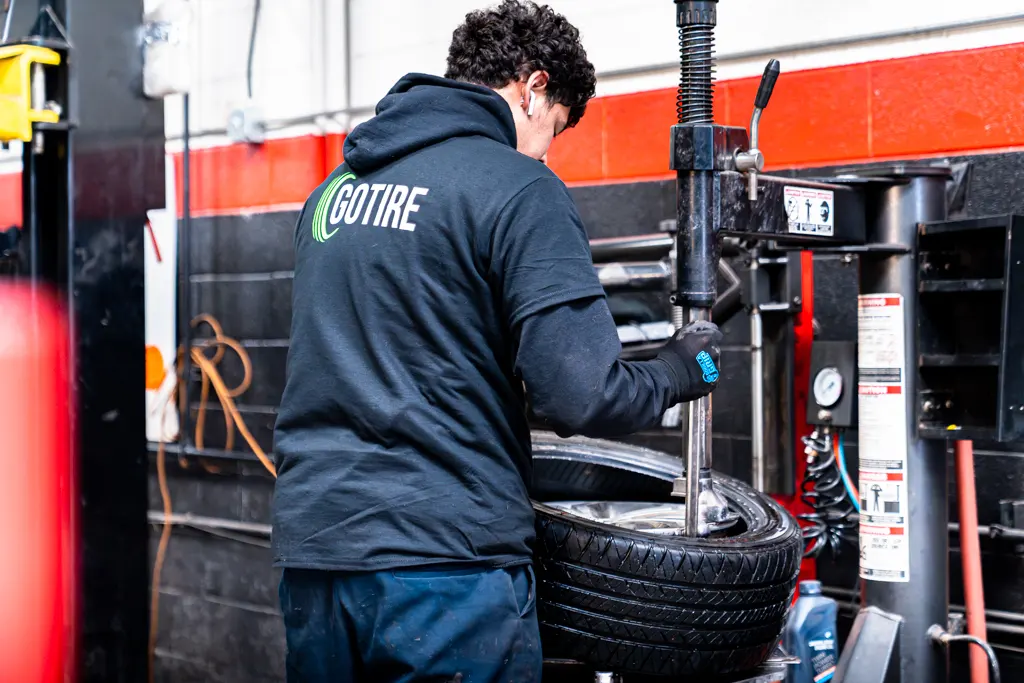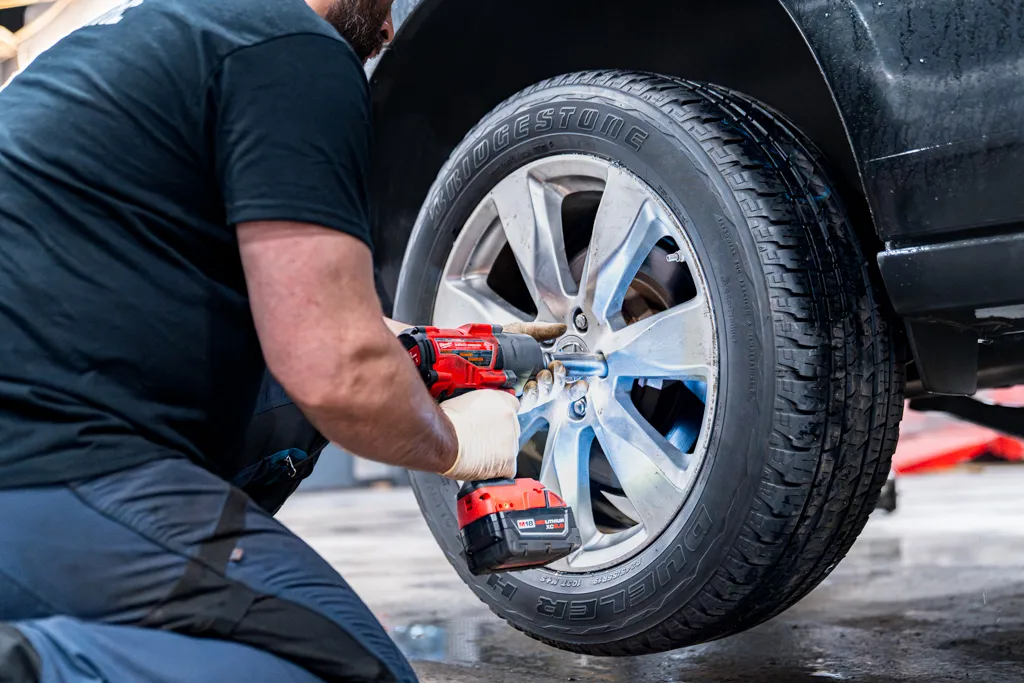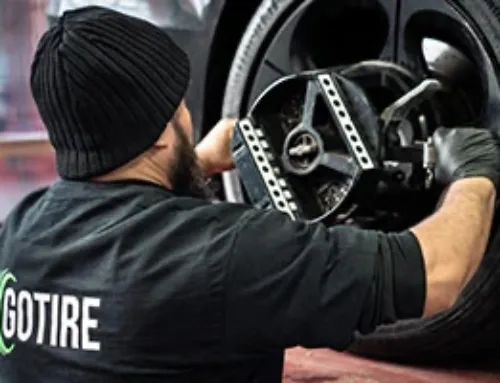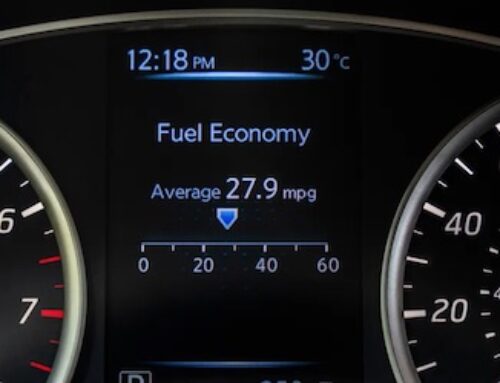Table of Contents
- How long does it take to get tires changed at an auto repair shop?
- Is it always faster to get my tires changed by a professional?
- How long does it take roadside assistance to change a tire?
- What locations can you have a tire or tires changed for cheap?
- Extend the life of your tires with regular tire inspections
- How long does it take to change a tire by yourself?
- Is it safe if I change my own tires?
- How to change tires on your own: the GoTire step-by-step Guide
- Frequently Asked Questions
There are many reasons for tires to be changed. You could be putting on your winter tires for the season, got a flat, or maybe it’s time to replace some old worn rubber with new tires. Sometimes changing a tire is an emergency; in these instances, you might wonder how long it will take before you’re back on the road again. Depending on the situation, changing a single tire or all four tires can range from just 10 minutes to several hours. In this article, we’ll break down each specific situation and give you an idea of how long it takes to change tires. Plus, we provide you with a step-by-step tutorial for changing tires on your own!

How long does it take to get tires changed at an auto repair shop?
Due to a technician’s experience and access to better tools such as an electric torque wrench, a lift, etc., a technician can replace a single car tire in about 10-15 minutes. You might only have one tire replaced because of a tire puncture or some other type of tire damage. If you are replacing old and worn tires, it is usually recommended that this be done in sets of two or four tires. A skilled mechanic should be able to replace a set of four tires in about 40-60 minutes.
If you are getting a set of new tires, we highly recommend that you get a wheel alignment while you are at it. A wheel alignment will make sure that you’re setting these new tires up for success. Without an alignment, you could be subjecting your brand-new tires to unnecessary and easily avoidable wear and tear.
Is it always faster to get my tires changed by a professional?

The simple answer to this is “No.” It’s not always faster to have tire changes done by a professional mechanic. Once you’ve changed a few tires on your own, the process will only take 15-20 minutes per tire. While a technician can change a car tire in just 10-15 minutes, you might have a long waiting time before they’re ready to help you. Most tire shops and automobile repair shops offer plenty of services that people can schedule in advance, so it’s likely that if you show up unannounced, they will be busy, and you’ll have to wait. Depending on the shop, Wait times can range from 5 minutes to several hours.
How long does it take roadside assistance to change a tire?
This will likely take the longest amount of time by far, so you should only call roadside assistance if you’re having some kind of emergency. This is because roadside assistance vehicles will need to travel to you to assist you. Depending on your location, this could only be 30 minutes or so, but it’s probably going to be more like an hour to several hours. However, if you do find yourself in an emergency where you need a tire change (such as a flat tire, a blowout, or some other kind of emergency), services such as AAA are invaluable and will be your only option. Again, these professionals can change tires with the best of them, so the tire change will only take a few minutes.
What locations can you have a tire or tires changed for cheap?
Getting your tires changed (or mounted) at any professional auto repair shop will be fairly cheap, but here is a list of several locations you’re likely to have near you and the costs involved.
At Walmart
Walmart’s Auto Care Center offers tire mounting for $11 for tires you bring to them. If you choose to purchase tires at Walmart, they will still charge a tire replacement fee, but they offer a lifetime (of the tire, not the human) package of services, which includes rotation, balancing, etc., for only $14 per tire.
At Costco
If you purchase new tires at Costco, they offer a similar lifetime package of services, which includes installing or mounting the tire, for only $18.99. Unfortunately, Costco will not extend this offer to tires you purchase elsewhere.
Extend the life of your tires with regular tire inspections

Over time, tires wear down and will need to be replaced. Your car’s tires will experience tread wear unevenly throughout their life. Scheduling regular inspections and maintenance can extend the life of your tires so that you won’t need to change your tires as often. Basic services like tire rotation, wheel balancing, and tire alignment can be done at auto shops for relatively little cost. Many car owners overlook tire maintenance, but it can save you hundreds of dollars in tire replacement costs and valuable time as well.
How long does it take to change a tire by yourself?
This highly depends on your available tools, how many tires you need to change, and your personal experience. If it’s your first time changing tires, then it might take up to an hour or more per tire. However, once you’ve done one or two tire replacements on your own, you should see this time drop significantly. Assuming you have all the necessary tools, it can take as little as ten minutes to change a tire.
Is it safe if I change my own tires?
Yes, it is safe to change a tire on your own. It’s a relatively simple and straightforward process with little to no danger involved. In fact, the only thing you are in danger of is looking like a total boss to your friends and family. Whether you have a flat tire, a tire puncture, or just want to swap out an old tire for a new tire, rest assured you will be able to do this on your own, either at home or on the side of the road if needed. That being said, there are some safety precautions you can take in case you can’t make it to a tire shop:
- Pull over onto the shoulder or a parking lot well away from moving traffic
- Put your hazard lights on for extra visibility
- Make sure the spare tire or new tire that you are putting on is in good shape and doesn’t have any odd bulges or punctures
How to change tires on your own: the GoTire step-by-step Guide

It might seem daunting to change a tire on your own, but trust me if I can do it, you can too. Other than some standard tools, all you need is some common sense and some elbow grease. Whether you have a flat tire, want to replace some old tires, or maybe it’s time to put those summer tires back on, just follow these simple steps to get the job done. But first, you need to make sure that you have the right tools.
Tools You Need
Most of the tools you need should be standard with every car. Typically these tools are located in the trunk, underneath the trunk liner. Once you’ve lifted that up, you should see a spare tire (either full-sized or a “donut”) and a set of tools. Sometimes these tools are in a small compartment on the side of the trunk. You should have:
- Spare tire or “donut”
- A car jack
- A lug wrench (also known as a tire iron)
Some other tools which don’t come standard but that you might want are:
- A pair of gloves
- A tire gauge
- A flashlight
- An electric tire pump
Step 1: Take a deep breath, remain calm
It can be a bit nerve-wracking to have a flat tire, especially while you are driving. But don’t panic. It happens all the time. Proceed calmly and slowly.
Step 2: Find a flat, level, and safe area
Once you’ve noticed that you need to change a tire, look for a flat, level, and safe area to park your car. If you’re doing a tire change at home, your driveway might be ideal. If you have a flat tire while driving, look for a good spot to pull over. A parking lot or a quiet street is a good location. Avoid a spot where cars might be whizzing by at high speeds and close quarters.
Step 3: Emergency brake
Once you’ve found a good location, put the car in park and put the emergency or parking brake on. This is to provide extra stability for the vehicle.
Step 4: Put the car jack in position
Consult your owner’s manual for the exact location you should put the jack. However, you can easily find the right location if you do not have your owner’s manual handy. The correct spot to put the jack in the front wheels is just behind the wheel hub. For rear wheels, the correct spot is just in front of the wheel hub.
Step 5: Loosen the lug nuts
Before you elevate the tire, take a moment to loosen the lug nuts, but not remove the lug nuts completely. Use the lug wrench (aka a tire iron) to attach to each of the lug nuts and unscrew them just past the point of being tight. This might be the hardest step of the whole process as those lug nuts can be on quite tight (at least, I hope they are). You might need to press down with your body weight to get that first bit of movement.
Step 6. Lift your vehicle with the jack
Use the jack to raise your vehicle into the air. Some jacks have a pump handle, but for many of them, you will need to insert the lug wrench and turn it to get the jack moving. It goes slow, but you will see the jack moving after a few spins. You only need to lift the vehicle until the wheel is an inch or so off the ground. Any more is overkill.
Step 7: Remove the wheel
Once the wheel is in the air, use the lug wrench to loosen and remove the lug nuts. Pro tip: put the lug nuts somewhere safe, like a pocket or a cup, as they tend to roll away if you put them on the ground. The tire should slide off once all the lug nuts have been removed. The tire can be a bit heavy, so it’s best to lift just a little bit as you pull out.
Step 8: Install the new tire
Take your spare tire and slide it onto the wheel bolts. Then attach the lug nuts and screw them into place with your hands until they are all on. Then use the lug wrench to tighten each lug nut completely. It’s best to tighten the lug nuts in a star pattern rather than just going from one to the next. Once the lug nuts are all on tightly, you can lower the jack slowly. Put the discarded tire into the trunk along with the other tools.
Step 9: Admire your work
It’s customary to take a minute with your hands on your hips and admire your work. It’s also ok to say something like “Well!” or “Hmmph” and then slap your hands together a bit. Feel free to mention to friends or family over the next few days how you had to change a tire, but make sure to do it casually so they know it was “no big deal.”
Frequently Asked Questions
Should all four tires be replaced at the same time?
Suppose you replace all four tires because one or more are worn out and past their life expectancy, then yes, this is considered best practice. Sometimes you can get away with replacing two tires, but if you bought the original four together and have been getting regular tire rotations, it’s probably best to replace all four.
Do you need an alignment after replacing one tire?
No, but if you’ve replaced all four tires, we highly recommend getting an alignment as well. You want to give your brand-new tires the best possible start in life, and alignment does this.
Can you drive on a flat tire?
The short answer to this is no, you really shouldn’t. Driving on a flat tire can damage the tire beyond repair, turning a simple patch job into the need to replace the entire tire. Once you’ve noticed that you have a flat, it’s best to pull over as soon as possible and put the spare on. If it’s an emergency and you must drive on a flat tire, then it’s best to do this very slowly and carefully.









